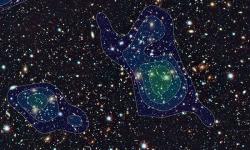Dark Matter Map Begins to Reveal the Universe's Early History
(Originally published by Kavli IPMU)
July 02, 2015

The latest results from the Subaru Telescope’s newest camera have captured nine large dark matter concentrations, each the mass of a galaxy cluster, more than one billion light-years from Earth.
The 870 million-pixel Hyper Suprime-Cam was installed on the Subaru Telescope in Hawaii in 2012, and was made available to researchers in March 2014. Researchers at the National Astronomical Observatory of Japan (NAOJ), lead by Associate Professor Satoshi Miyazaki had spent more than 10 years developing the camera so they could get data of faint distant objects over a wide area of sky. The Kavli Institute for the Physics and Mathematics of the Universe (Kavli IPMU) has collaborated with the Hyper Suprime-Cam’s development since 2007.
The camera enables researchers to accurately study how the light from distant objects are bent by dark matter. In fact, this is one of the only ways to study the mysterious matter that makes up more than 80 per cent of all matter in the universe. Creating a clear map of where dark matter is can help researchers figure out what it is, its role in the expansion of the universe, and it should reveal some of the physical properties of dark energy.
The latest data was taken over a two-hour exposure covering 2.3 square degrees of sky, revealing crisp images of numerous galaxies. By measuring the individual shapes of galaxies, the team created a map of the dark matter hiding in the foreground. The result was the discovery of nine clumps of dark matter, three times as more than what current theoretical models had predicted, which was published on July 1 in Astrophysical Journal.
The ultimate goal of this project will be to continue to map 1000 square degrees of sky.
Kavli Institute for the Physics and Mathematics of the Universe Director Hitoshi Murayama’s comment on this paper: “It became very clear that the large-scale observational program using the HSC has now in full steam. We can now observe the Universe both deep and wide, and study the distribution of dark matter, evolution of the structure, and the nature of dark energy lurking behind them. At the same time, we will surely discovery many astronomical objects too faint or too far away which we could not see before. I’m excited and looking forward to see amazing results working closely with NAOJ, Princeton, and ASIAA.”
Paper details
Miyazaki et al. (2015) “Properties of Weak Lensing Clusters Detected on Hyper Suprime-Cam 2.3 Square Degree Field”, Astrophysical Journal, 807, 22
DOI: 10.1088/0004-637X/807/1/22
To read a preprint of the paper, click here.
Useful links
For more details please refer to the NAOJ press release: http://subarutelescope.org/Pressrelease/2015/07/01/index.html
About the NAOJ: http://www.nao.ac.jp/en/
About the Hyper Suprime-Cam: http://www.naoj.org/Projects/HSC/